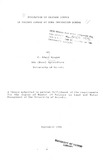| dc.description.abstract | The research project addresses itself to the evaluation
of seepage losses in unlined canals in the scheme. The
objectives of the study, were; to evaluate seepage losses in
the conveyance and distribution system, investigate and
analyse the factors influencing seepage losses; and develop
management and operational strategies for improvement of
conveyance efficiency in the supply and distribution systems
of the scheme.
Seepage evaluation was done in the major conveyance and
distribution systems of the scheme, using the inflow-outflow,
seepage meter and ponding methods.
Seepage losses in the supply canal obtained by inflowoutflow
and seepage meter methods are 22.6 l/s/km (1.1 %/km)
and 9.49 l/s/km (0.38%/km),
represent 39.8% and 14.0%
respectively, in the supply
respectively. These results
loss of the inflow discharge,
can aL, which is about 36.8 km
long. Results reported from studies on seepage, elsewhere,
indicate that seepage losses in the supply canal range from 3
to 86% of the inflow discharge.
Evaluation in the night storage reservoirs indicate
that seepage losses are 0.39 and 0.28 cm/day on average.
Results obtained from other studies on general soils, report
seepage to range from 20 to 58 cm/day.
Assessment of effects of seepage on ground water rise
indicate that the rise range from 0.03 to 0.01 m/year. Thus,
it would take the ground water table (estimated at less or
equal to 30 ro from ground surface) about 1,000 to 3,000 yars
to reach the ground surface. The only adverse effect to be
caused by rising ground water table, in the short run, would
be expected to occur only in those sections overlying perched
water table.
Lining cqnsiderations on the conveyance and
distribution systems and the consequent unjt cost of lining
were assessed. Seepage losses were evaluated to be low.
Lining option could be undertaken if cost of lining is less
than the un i t cost of water lost thr ough seepage, report ed,
as Kshs. 2.05 per metre square.
Improvement on water use efficiency could be acheived
in Bura Irrigation Settlement Scheme through better operation
and maintenance programme in the supply and distribution
system. | en |

